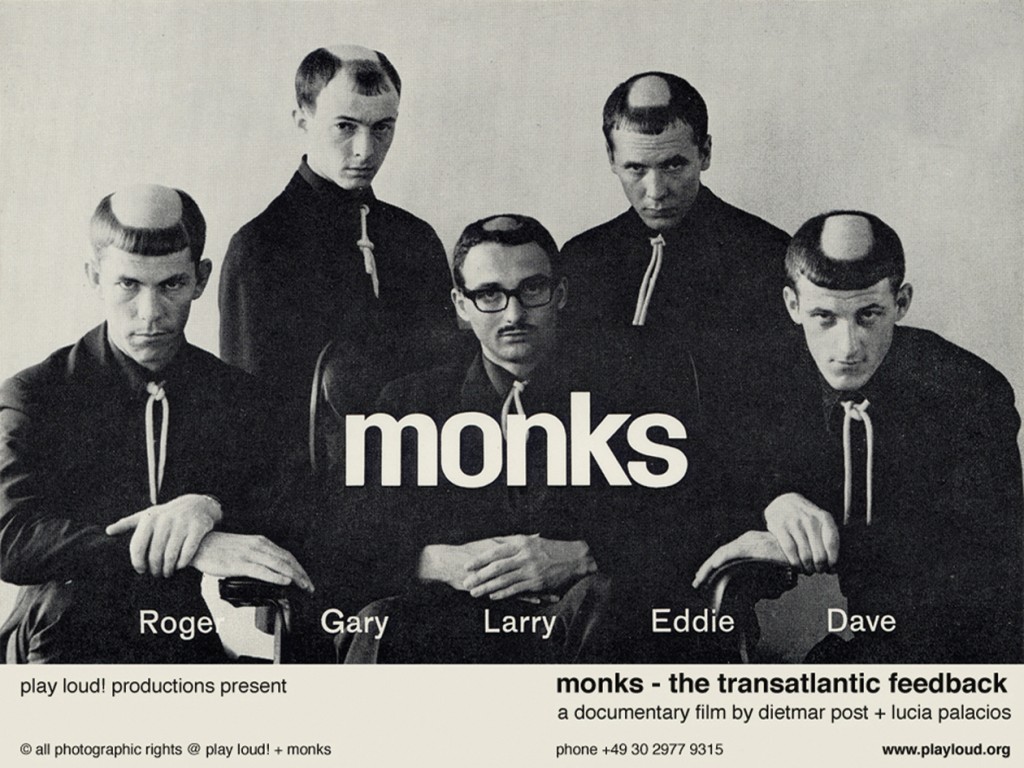The Monks: Transatlantic Feedback Review
 “Sunlight grids quiver in the system. Read on! It’s monk time – it’s hop time. don’t read this. We said: don’t read this. Let sapphires glide into the grooves. What is beat? What is beat today? And what is over-beat? And who the hell is going to melt the hot and cold world of tomorrow?”
“Sunlight grids quiver in the system. Read on! It’s monk time – it’s hop time. don’t read this. We said: don’t read this. Let sapphires glide into the grooves. What is beat? What is beat today? And what is over-beat? And who the hell is going to melt the hot and cold world of tomorrow?”
The above is the beginning of the liner notes to the original release of The Monks truly incredible album Black Monk Time. Released in 1965 and, as the above introduction testifies to, not just a simple rock ‘n’ roll album, The Monks Black Monk Time was an explosive début with catchy hooks but an experimental approach to sound.
The Monks were a group of five American GIs stationed in Germany in the sixties who in 1964 formed a band called The Torquays and played standard rock ‘n’ roll classics in local bars and venues. The band started out doing covers of surf rock hit including songs by the Beach Boys and Rufus Thomas but they later moved on to cover British groups such as The Beatles, The Rolling Stones and The Kinks. As their influences changed their music also began to evolve. Following the end of their tour of duty the group decided to stay in Germany and continued playing in bars, cutting their first record as ‘The 5 Torquays’.
In 1965 they changed their name to The Monks and their music began to shift more and more into the sound that became Black Monk Time. The music was heavily driven by the rhythm and feedback, with clashing harmonics and discordant sounds The Monks pushed beyond being simply a covers band and recorded a seminal album of the sixties that still hugely influences musicians to this day.The final line up of The Monks, after various changes through the early sixties, was Gary Burger (Vocals/Guitar), Larry Clark (Organ), Roger Johnston (Drums), Eddie Shaw (Bass) and Dave Day (Guitar/Banjo). It was the inclusion of instruments such as the organ and banjo and their approach to the other instruments that helped form their unique sound. Also hugely important was the vocals by Gary Burger, which sound as startling today as they must have done to an unprepared mid-sixties audience.
Transatlantic Feedback tells the short narrative of this band, the story behind the scenes that resulted in the 1966 release of Black Monk Time and the events that have occured since the band’s split. The band are well known not just for their electrifying sound but also their iconic look, with monk haircuts the band always dressed in black and were sometimes even photographed with nooses around their necks. One of the most fascinating elements of the documentary is the story of The Monks management, Karl-H Remy and Walther Neimann, who helped cultivate this image, setting the band up as the ‘anti-Beatles’. The film portrays the managers as mysterious figures who helped guide the band with rigid rules and a corporate mentality.
The managers even had a set of six rules that the band had to follow to be ‘a Monk’, rules that had to be followed on and off stage. The managers ultimately split up though signalling the end of The Monks. The band reformed in 1999 and played what was actually their first ever US live date to a thrilled audience, including many contemporary musicians.
This performance signals the end of the documentary and with the recent deaths of three of the members of The Monks the story of the band appears to be over. But their music is kept alive by the new fans discovering the album and the legacy of influence that The Monks’ sound has had on artists as diverse as The Fall, The White Stripes, The Dead Kennedys and Throbbing Gristle.
The documentary has amazing clips but ultimately suffers from the lack of footage available of The Monks on and off stage in the sixties. We are of course treated to talking heads of the band members, who surprisingly downplay the significance of The Monks and the impact on their lives. It seems that they are not quite aware of the extent of the cult following of The Monks until they perform again.